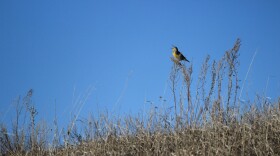The Orionid Meteor Shower is putting on its annual show now. It started on October 2 and will go to November 7. The shower will peak on the evening of October 21 and early morning hours of the 22 with perhaps twenty or so meteors per hour. We are fortunate to have a crescent moon during the peak viewing period, so if the sky is clear, we could be in for a good show.
The Orionid meteor shower occurs every fall as the earth passes through the debris field of Halley’s Comet. The meteor shower is called the Orionids because the meteors are seen radiating out of the constellation Orion although they may be seen in other parts of the night sky. The Taurids Meteor Shower is also on now and will peak the evening of November 4 and early morning hours of the 5. Those meteors will appear to originate within the constellation Taurus.
While you are watching the Orionids, you might also want to make a point of viewing the constellation Orion. It is one of the easier constellations to identify in the autumn sky. By around 11:00 central time, Orion should be fully visible in the eastern sky. Look for four bright stars forming a crude rectangle orientated somewhat vertically. That is Orion, the great hunter. Within that rectangle, near the middle are three prominent stars arrayed in a row, roughly equidistant, and dipping to the left. That’s Orion’s belt. You should also notice a couple stars in a hazy area a little below the middle of Orion’s belt. That is Orion’s sword.
Orion, of course, was a prominent feature in Greek mythology. He was a highly regarded hunter. There are several myths about Orion, one of which has him dying from stepping on a scorpion. So, for his eternal safety, the gods placed him in the heavens well away from the constellation Scorpius, the scorpion. He can be seen up there with the constellations his two dogs, Canus major and Canus minor, fighting Taurus the bull, and hunting Lepus the hare.
So, make a point to watch the Orionids. It is one of the better meteor showers of the year. And consider taking along star chart to help in finding Orion, Canus major and Canus minor (the two dogs), Taurus (the bull), and Lepus (the hare). Star charts are widely available in bookstores, online, and apps for your cell phone.





